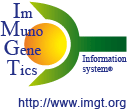Citing this page: Lefranc, M.-P. and Lefranc, G. Human Gm, Km and Am allotypes and their molecular characterization: a remarkable demonstration of polymorphism In: B. Tait, F. Christiansen (Eds.), Immunogenetics, chap. 34, Humana Press, Springer, New York, USA. Methods Mol. Biol. 2012; 882, 635-680. PMID: 22665258
Part 2 - Prevalent Gm haplotypes of the human IGHG3, IGHG1, and IGHG2 alleles in different populations
The Gm system is very instrumental for population genetics research, as it is highly polymorphic and unbalanced with respect to linkage. This system is unique in its ability to characterize human populations by specific sets of haplotypes [1-7]. Specific Gm haplotypes are found in Negroid, Caucasoid and Mongoloid populations. Thus, Gm 5*;3;.. and Gm 5*;3;23 are only typical of the Caucasoids, whereas three Gm haplotypes only occur in the Mongoloids: Gm 15,16*;1,17;.. largely in the northern hemisphere, and Gm 5*;1,3;.. and Gm 5*;1,3;23 in the southern hemisphere. The whole set of Gm haplotypes in the Negroids is unique, while the Caucasoids and Mongoloids have two haplotypes in common, Gm 21*;1,17;.. and Gm 21*;1,2,17;.. [8,9]. Vast screenings of human populations worldwide have uncovered considerable variability both in the contents of Gm haplotypes and in their frequencies, which enabled the investigators to examine valuable data with regard to genogeography, ethnoanthropology, evolutionary and population genetics, and forensic medicine [4,5,10-15] and on molecular evolution of the IGH locus [2,8,9,16-20].
Citing this table: Lefranc, G. et al. 1982 [8], 1983 [9].
| Populations | Prevalent Gm haplotypes (1) |
|---|---|
| Caucasoids | Gm 5*;3;.. Gm 5*;3;23 |
| Caucasoids and Mongoloids |
Gm 21*;1,17;.. Gm 21*;1,2,17;.. |
| Negroids | Gm 5*;1,17;.. Gm 6,24*;1,17;.. Gm 6*;1,17;.. Gm 15*;1,17;.. |
| Mongoloids |
Gm 15,16*;1,17;.. Gm 5*;1,3;.. Gm 5*;1,3;23 |
- (1) For more details, see Part 1.
| [1] |
Lefranc, G. et al., Acta Anthropogenetica, 1, 34-45
(1976)
When citing this paper, please add also the following information: on-line at IMGT, the international ImMunoGeneTics information system®, http://www.imgt.org (IMGT Repertoire>Allotypes>IGHC>Human>Part 1 and Part 2) |
| [2] | Lefranc, G. et al., Am. J. Hum. Genet., 28, 51-61 (1976). |
| [3] | Gershowitz, H. and Neel, J.V., Am. J. Phys. Anthropol., 49, 289-301 (1978). |
| [4] | Lefranc, G. et al., Hum. Genet., 41, 197-209 (1978). |
| [5] | Lefranc, G. et al., Hum. Genet., 50, 199-211 (1979). |
| [6] | Steinberg, A.G. and Cook, C.E. The distribution of the human immunoglobulin allotypes. Oxford University Press, Oxford (1981). |
| [7] | Zhao, T. and Lee, T.D., Hum. Genet., 83, 101-110 (1989). |
| [8] | Lefranc, G. et al., J. Immunogenet., 9, 1-9 (1982). |
| [9] | Lefranc, G. et al., Eur. J. Immunol., 13, 240-244 (1983). |
| [10] | Lalouel, J.M. et al., Acta Anthropogenetica, 1, 15-33 (1976). |
| [11] | Crawford, M.H. and Enciso, V.B., Population structure of circumpolar groups of Siberia, Alaska, Canada and Greenland. In: M.H. Crawford, J. Meilke (eds) Methods and theories of anthropological genetics. University of New Mexico Press, Albuquerque, pp. 51-91 (1982). |
| [12] | Helal, A.N. et al., Exp. Clin. Immunogenet., 5, 1-14 (1988). |
| [13] | Schanfield, M.S., Hum. Biol., 64, 381-402 (1992). |
| [14] | Cavalli-Sforza, L.L. et al., The history and geography of human genes. Princeton University Press, Princeton, New Jersey (1994). |
| [15] | Osipova, L.P. et al., Hum. Genet., 105, 530-541 (1999). |
| [16] | Lefranc, M.-P. et al., Nature, 300, 760-762 (1982). |
| [17] | Lefranc, M.-P. et al., Mol. Biol. Med., 1, 207-217 (1983). |
| [18] | Lefranc, G., et al., J. Immunogenet., 6, 215-221 (1979). |
| [19] | Lefranc, M.-P. et al., Immunodefic. Rev., 2, 265-281 (1991). |
| [20] | Wiebe, V. et al., Hum. Genet., 93, 520-528 (1994). |



